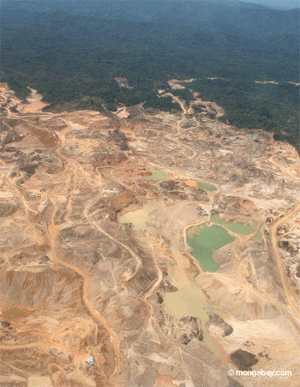Peru seeks $200 million to save its rainforests
mongabay.com
December 8, 2008
Peru is seeking $200 million in international contributions over the next ten years to cut deforestation to zero, reports BBC News.
Speaking to BBC News at the U.N. climate meeting in Poznan, Poland, Environment Minister Antonio Brack said Peru would aim to conserve 54 million hectares of forest over the next 10 years, an area that could eventually rise to 60 million. He said the country is seeking 20 million per year from industrialized nations to augment the $5 million the Peruvian government is willing to commit. He added that the government believes 80 percent of the country’s primary or old growth forests can be saved.
“We are not a poor country going to the Poznan meeting begging for aid,” he told the BBC. “We are an important country with a large area of forest that has a value.”

|
The Peruvian proposal segments the 54 million hectares into four categories: 17 million hectares of existing national parks, 12 million for indigenous reserves, 21 million for sustainable forestry development, and 5 million for eco-tourism. Some of the funds would go towards increasing the country’s nascent environmental police force from 61 officers to more than 3,000.
While it wasn’t initially clear how reducing emissions from deforestation and degradation (REDD) mechanism would play into Peru’s proposal, the emergence of a market for forest carbon could be worth hundreds of millions of dollars to the country.
Peru’s forests
Peru — home to the fourth largest extent of tropical rainforests after Brazil, Congo, and Indonesia — has historically had one of the lowest annual deforestation rates in the Amazon basin, but forest loss has been increasing in recent years due to illegal logging, mining, agriculture, and expansion of road networks, including the paving of a highway that provides access to a remote and biologically-rich region in southeastern part of the country. In 2005 — the most recent year for which data is available — at least 150,000 hectares of forest was lost, while a similar area was degraded through logging and other activities.
Deforestation accounts for roughly half of Peru’s greenhouse gas emissions, according to WWF. Spanning a variety of ecosystems, including the dry coastal region, the tropical Amazon, and the high Andes, the country is particularly vulnerable to climate change. The Peruvian government estimates that the country’s glaciers have shrunk by more than 20% in the past 30 years and expects them all to disappear by 2040. The loss of glaciers, which are the source for as much as 50 percent of the water in the upper Amazon, could have a significant impact on agriculture and urban water supplies as well as the Amazon rainforest.







